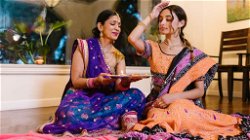Different Types of Sarees From Across the Country
James Bond
. 2 min read
Saree is an expression of the cultures and traditions that mark our country. The elegance of a saree is unmatched and that is why all of us love this special attire. A timeless ethnic piece of clothing, different types of Sarees can be found across the length and breadth of the Country. The standard nine yards of drape can be modeled and styled variedly depending on the different types of sarees in India. Through video chat, we can explore and appreciate the diverse ways the standard nine yards of drape can be modeled and styled with different types of sarees..

Different Types of Sarees in India
Kanjeevaram Saree from Tamil Nadu
This is a 9 yard long saree with designs of temples patterened on it. Over a period of time, Kanjivaram sarees got converted in 6 yards with gold zari weaving. Those are really very much costly. In order to make it a bit cost effective, artificial zaris are used which look almost like the original zari.
Nauvari Saree from Maharashtra
Historically, the women of the Maratha Empire showcased their abilities and caliber by assisting their fellow male warriors during the times of war. Hence, in order to accomplish their mission and yet maintain their comfort of physical movement during the wars, these Marathi women invented this Maharashtrian style of drape.
Tant Saree from West Bengal
Tant refers to the handlooms in West Bengal which are used to weave saris and textiles. The earliest record of sari weaving in Bengal can be traced back to the 15th century in the Shantipur district. The art continued to flourish during the Mughal rule, from the 16th to the 18th centuries, when it received extensive royal patronage alongside muslin and jamdani.
Bomkai Saree from Odisha
The Bomkai saree has been originated from a small picturesque village called Bomkai in Ganjam district, 156 Km from Bhubaneswar in Odisha. Latter on it is introduced in Sonepur. Before 1950’s the main product mix of this area was cotton sari and dhotis. The main occupation of “Bhulia” community was weaving.
How to distinguish genuine Bomkai Saree
Traditionally, these are distinct in their use of heavily plied cotton, with stylized floral and geometrical patterns in the borders and contrast colour border and pallu (muhajorha). Body and pallu warp are joined to get contrast colour effect. Sometimes it combines bandha (tie dye) and supplementary
Kasavu Saree from Kerala
What is a Kasavu Saree?
The term kasavu actually refers to the zari used in the border of the Kerala sari and not the sari itself. It is the name of a material used in the manufacturing process. Thus, when kasavu becomes a part of the mundu (dhoti), it’s called a kasavu mundu.
Phulkari Saree From Punjab
The term Phulkari is a Punjabi term is obtained from two words, ‘Phul’ and ‘Kari’ meaning ‘flower’ and ‘work’ and so the word Phulkari translates into ‘flower work’ or ‘floral work’. The Phulkari embroidery first began in Punjab in the 15th century by the women of Punjab. It is the rural handmade embroidery tradition of Punjab and is also known as the folk embroidery of Punjab.
More Stories from
CFDA: Supporting American Fashion & Venturing into Web3
This article provides an overview of the Council of Fashion Designers of America (CFDA), its mission, and its programs to support American fashion designers.
Finding the Perfect Engagement Ring: Style and Affordability Unite
This article offers valuable insights on how to choose a stylish and affordable ring that complements your partner's taste and fits your budget.
Fashion Blogging: Unleashing Your Style and Creativity Online
Discover the rise of fashion blogging, its powerful influence on the fashion industry, and how to start your own blog.
The Timeless Elegance of Sarees for Weddings: A Guide for Brides and Guests
Whether you're a bride or a guest, this article provides valuable insights to help you make the perfect choice for your next wedding celebration.









.png?width=40&aspect_ratio=1:1)
